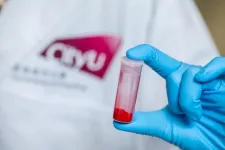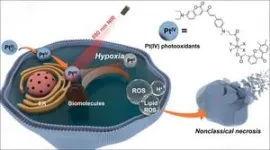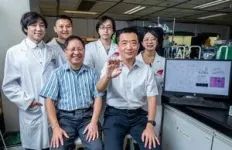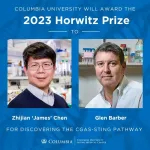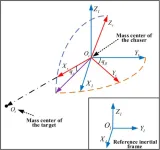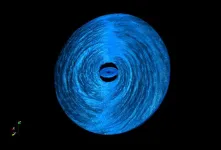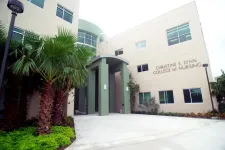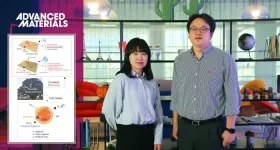(Press-News.org) A research team led by scientists from City University of Hong Kong (CityU) has achieved a significant breakthrough by inventing a new class of near-infrared-activated photo-oxidants that can effectively kill cancer cells without requiring oxygen. The photo-oxidants induce a unique form of cancer cell death that can overcome cancer cell resistance. The findings offer a new strategy, called ‘photo-oxidation therapy’, and provide a promising direction for the development of anti-cancer drugs.
Photodynamic therapy, an innovative cancer treatment approach, utilizes photosensitizers to generate reactive oxygen species (ROSs), which when irradiated by light, selectively kill cancer cells. However, most existing photodynamic therapies rely on the presence of oxygen, while solid cancer tumours often feature a hypoxic microenvironment with very low oxygen levels, limiting the therapeutic efficiency of this approach.
To address this limitation, a research team led by Professor Zhu Guangyu, in the Department of Chemistry, and Professor He Mingliang, in the Department of Biomedical Sciences (BMS) at CityU, discovered an effect called “metal-enhanced photo-oxidation”. By conjugating metals like platinum with organic photosensitive ligands, they significantly enhanced the photo-oxidation capability. This breakthrough led them to develop a new class of near-infrared-activated platinum(IV) photo-oxidants (Pt(IV) photo-oxidants) that can be activated by near-infrared (NIR) light to directly oxidize biomolecules and effectively kill cancer cells without the need for oxygen.
In their experiments, the team administered Pt(IV) photo-oxidants to mice with tumours through intravenous injection. Four hours later, they applied near-infrared radiation to the mice to activate the photo-oxidants to attack the cancer cells. The results demonstrated a significant reduction in tumour volume and weight of 89% and 76%, respectively, indicating the potent tumour-inhibitory effect of the Pt(IV) photo-oxidants.
“Intriguingly, we found that the ‘death mode’ of cancer cells induced by the Pt(IV) photo-oxidants differs from that of any other anticancer agents,” said Professor Zhu. “A unique mode of cancer cell destruction was initiated through the dual-action effect of strong intracellular oxidative stress and reduced intracellular pH value.”
Their experimental data show that after the Pt(IV) photo-oxidants that accumulated in the endoplasmic reticulum inside the cancer cells were activated by near-infrared radiation, they vigorously oxidized crucial biomolecules inside the cancer cells without requiring oxygen, generating ROSs, lipid peroxides and protons. The ROSs and lipid peroxides then triggered intensive oxidative bursts, while the protons lowered the intracellular pH value, creating an unfavourable acidic microenvironment for the cancer cells.
Moreover, their experiments confirmed that Pt(IV) photo-oxidants effectively activate the immune system in both in vitro and in vivo settings. The Pt(IV) photo-oxidants triggered immunogenic cell death, stimulating the proliferation and activation of immune cells. The number of T helper and T killer cells, which are crucial for triggering the body’s immune response, in the mice treated with photoactivated Pt(IV) photo-oxidants increased by 7- and 23-fold, respectively, compared to the control group.
“By inducing nonclassical necrosis, Pt(IV) photo-oxidants can overcome the resistance of cancer cells to traditional photodynamic therapies and chemotherapy agents, activate the immune system, and effectively eliminate cancer cells,” explained Professor Zhu.
“These findings serve as proof of concept and suggest that the development of photo-oxidants based on metal-enhanced photo-oxidation is a promising new direction for developing metal-based anticancer drugs,” said Professor He.
The research team plans to conduct preclinical studies to fully characterize the chemical, biological and pharmaceutical properties of the newly invented Pt(IV) photo-oxidants. Their ultimate goal is to identify lead compounds for clinical testing.
The paper, titled “Near-infrared-activated anticancer platinum(IV) complexes directly photo-oxidize biomolecules in an oxygen-independent manner”, was published in the scientific journal Nature Chemistry.
The co-first authors of the study are Dr Deng Zhiqin and Dr Li Huangcan, both from CityU. The corresponding authors are Professor Zhu and Professor He. Collaborators from CityU include Professor Michael Yang Mengsu, Professor Lu Jian, Professor Li Yangyang, Professor Lo Pui-chi, Professor Lei Dangyuan, Dr Ou Weihui, Dr Wang Na, Dr Chen Shu and PhD students Mr Liu Gongyuan, Mr Xu Feijie and Mr Wang Xiong.
The study received support from various funding sources, including the Hong Kong Research Grants Council, the National Natural Science Foundation of China, and the Science Technology and Innovation Committee of Shenzhen Municipality.
https://www.cityu.edu.hk/research/stories/2023/09/20/cityu-researchers-develop-novel-photo-oxidation-therapy-anticancer-treatment
END
CityU researchers develop novel photo-oxidation therapy for anticancer treatment
2023-09-20
ELSE PRESS RELEASES FROM THIS DATE:
Multimillion-dollar scientific grant program releases third cycle of funding to increase foundational understanding of sarcoidosis
2023-09-20
WASHINGTON (September 20, 2023)—The Ann Theodore Foundation Breakthrough Sarcoidosis Initiative (ATF-BSI), in partnership with the Milken Institute, launched its latest round of funding today. Up to $3.4 million in total funding will be made available to researchers from around the world whose work aims to increase scientific understanding of sarcoidosis. The program is accepting applications for two-year research projects and intends to award four to six research grants from doctorate-level investigators at qualifying research-based institutions worldwide. Awardees may be eligible for a third year of funding.
Sarcoidosis is an inflammatory ...
Zhijian ‘James’ Chen and Glen Barber awarded Horwitz prize for discovering the cGAS-STING pathway
2023-09-20
NEW YORK, NY (September 20, 2023)—Columbia will award the 2023 Louisa Gross Horwitz Prize to Zhijian ‘James’ Chen and Glen Barber for discovering the cGAS-STING pathway, a key component of one of the body’s first line of defenses, the innate immune system.
When pathogens infiltrate our cells, they leave behind traces of their DNA. These molecular fingerprints are detected by our cGAS-STING pathway, which sounds the alarm and mobilizes the immune system to eliminate invading threats. Research on the cGAS-STING pathway has revealed the ...
Scientists researched on finite-time anti-saturated proximity control with a tumbling non-cooperative space target
2023-09-20
The past few decades have witnessed the burgeoning development of on-orbit servicing in light of various meaningful space applications such as repair of malfunctioning satellites, debris removal, on-orbit assembly, and so on. As for the orbit-servicing targets, they are usually divided into 2 categories, i.e., cooperative and non-cooperative ones, based on whether the space targets have active cross-link communication and cooperative identifiers with the servicing spacecraft or not. Before executing the orbit-servicing task, close-range rendezvous and proximity is an inevitable process in which ...
Australian biobank aims to discover new treatments for children with genetic muscle diseases
2023-09-20
An Australian-first biobank will be established to improve and discover new treatments for children with genetic muscle diseases.
The National Muscle Disease Bio-databank, co-led by Murdoch Children’s Research Institute, Monash University and Alfred Health, will advance research into understanding why children develop genetic muscle diseases. The project forms part of a $2.5 million Medical Research Future Fund grant awarded to the team for research into congenital muscle diseases.
These diseases, spanning dystrophies and myopathies, are characterised by severe muscle weakness, usually from infancy, that can impact swallowing, ...
A study published in Chinese Medical Journal reveals potential of methotrexate to treat liver cancer
2023-09-20
Liver cancer is one of the most prevalent and deadly types of cancer worldwide. Most patients are diagnosed at an advanced stage, which leaves them with few treatment options. Unfortunately, the first-line drugs used in advanced hepatocellular carcinoma (HCC), the most common type of liver cancer, are not very effective and offer only modest clinical benefits.
Over the past few years, scientists have been trying to develop new therapies for HCC by analyzing specific genetic abnormalities and the ways in which they affect the manifestation and progression of the disease. One of the most common mutations in HCC ...
State Council in Virginia approves new UVA Data Science Major
2023-09-20
The State Council of Higher Education for Virginia (SCHEV) approved Tuesday the creation of an undergraduate major for the University of Virginia’s School of Data Science, a landmark development for the four-year-old school, which was the first of its kind in the nation.
Prior to Tuesday’s announcement, undergraduates could obtain a minor in data science, while graduate students could pursue master’s or doctoral degrees. Now, the establishment of the B.S. in Data Science will allow UVA’s undergraduates to focus their studies on this emerging and growing interdisciplinary field.
“The B.S. in Data Science major is a major milestone ...
A newly identified virus emerges from the deep
2023-09-20
Highlights:
Organisms, including viruses, live in the deepest, darkest places on the planet
Marine virologists analyzed sediment from the Mariana Trench, the deepest place on Earth, and identified a new bacteriophage
The phage infects Halomonas bacteria, which have been found in deep-sea environments and near hydrothermal vents
The study helps probe how phages and hosts evolve together in secluded, hostile environments
Washington, D.C. — The Mariana Trench, the deepest place on Earth, plunges nearly 11,000 meters at its lowest point on the floor ...
Black holes eat faster than previously expected
2023-09-20
A new Northwestern University-led study is changing the way astrophysicists understand the eating habits of supermassive black holes.
While previous researchers have hypothesized that black holes eat slowly, new simulations indicate that black holes scarf food much faster than conventional understanding suggests.
The study will be published on Wednesday (Sept. 20) in The Astrophysical Journal.
According to new high-resolution 3D simulations, spinning black holes twist up the surrounding space-time, ultimately ripping apart ...
FAU receives $1.3 million grant for Alzheimer’s outreach in Broward County
2023-09-20
Florida Atlantic University’s María de los Ángeles Ortega, DNP, APRN, in the Christine E. Lynn College of Nursing, has been awarded a three-year, $1.3 million grant from the Administration for Community Living’s (ACL) Alzheimer’s Disease Program Initiative for a groundbreaking project designed to advance health equity and improve quality of life for individuals living with or at high risk for Alzheimer’s disease and related dementias (ADRD) and their family caregivers.
ACL was created around the fundamental principle that all people, regardless of age or disability, should be able to live independently ...
New Si-based photocatalyst enables efficient solar-driven hydrogen production and biomass refinery
2023-09-20
A team of researchers, led by Professor Jungki Ryu in the School of Energy and Chemical Engineering at UNIST and Professor Soojin Park from Pohang University of Science and Technology (POSTECH), have achieved a significant breakthrough in the development of a hybrid silicon photocatalyst. This innovative catalyst utilizes solar power to produce hydrogen and high-value compounds efficiently, marking a major step forward in green hydrogen production technology.
The newly developed photocatalyst is both non-toxic and eco-friendly, addressing the limitations associated with ...
